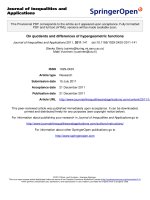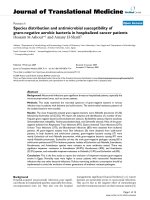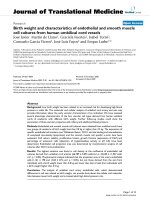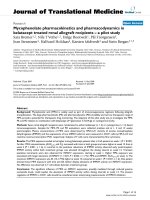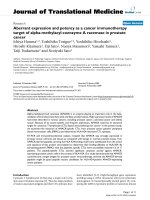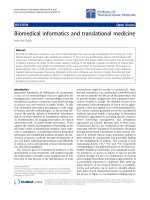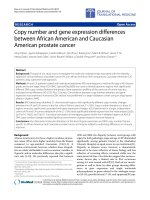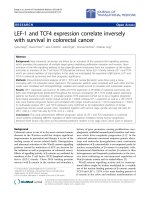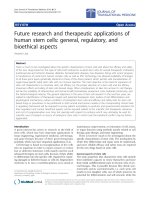báo cáo hóa học:" Hind-foot correction and stabilization by pins in plaster after surgical release of talipes equino varus feet in older children" pot
Bạn đang xem bản rút gọn của tài liệu. Xem và tải ngay bản đầy đủ của tài liệu tại đây (1.39 MB, 8 trang )
El-Sayed and Seleem Journal of Orthopaedic Surgery and Research 2010, 5:42
/>Open Access
REVIEW
© 2010 El-Sayed and Seleem; licensee BioMed Central Ltd. This is an Open Access article distributed under the terms of the Creative
Commons Attribution License ( which permits unrestricted use, distribution, and repro-
duction in any medium, provided the original work is properly cited.
Review
Hind-foot correction and stabilization by pins in
plaster after surgical release of talipes equino varus
feet in older children
Mohamed M El-Sayed*
1
and Osama A Seleem
2
Abstract
Congenital talipes equino varus (CTEV) is a three dimensional deformity and is one of the most common congenital
abnormalities affecting the lower limb and can be challenging to manage. Hind-foot deformity is considered the most
difficult to treat. Unfortunately, the calcaneus is often small and thus difficult to control during casting after surgical
release in severe or relapsed cases. We used three pins to control and maintain the hind foot correction, after surgical
release, during casting in 47 cases (59 feet). We introduced a modified, coronal plane, transverse calcaneal pin. This pin
is inserted from medial to lateral through the calcaneus to correct the varus mal-positioning of the calcaneus in the
sagittal plane and to provide a better control on the small sized, hind-foot during casting. We paid special attention to
the final hind-foot deformity after surgery, and the results were favorable after the application of this transverse pin.
Introduction
CTEV is a complex deformity that has a tendency to
recur until the age of six or seven years [1]. Recently after
the introduction of the Ponseti method, there is almost a
universal agreement on the non-operative management
of CTEV [2-6].
It is likely that a small number of clubfeet will require
surgery even after expertly applied non-operative treat-
ment. In some patients, either failure to obtain a com-
plete correction or failure to maintain the correction
occurs [6].
In those patients with severe relapsed deformities, the
calcaneus is often small and difficult to control during
casting. A residual varus mal-positioning of the hind-foot
may occur, after complete adequate surgical release. We
used three pins to control and maintain the hind foot cor-
rection in the normal position (about 5° valgus) during
casting in the studied 59 feet.
Patients and Methods
Between Oct. 2003 and Sept. 2009, 47 cases (59 feet) of
CTEV, were operated upon using the below described
surgical technique. The parents gave the informed con-
sent to include their kids into the study. There were 35
unilateral cases and 12 bilateral cases. The duration of
previous conservative management ranged from 5 to 22
months, with a mean of 12 months.
In all cases, a trial of conservative management, using
the Ponseti method, was strongly suggested at our center
which was not accepted by the parents of all the children
included in this study. History of previous treatment is
summarized in (Table 1) and demonstrates a history of
good initial results and deformity correction following
previous conservative management that was reported In
16 unilateral, and 5 bilateral patients using the Ponseti
method. This was not maintained and the deformity
recurred in this group of patients, and that was attributed
to the poor family compliance, inadequate orthosis, and/
or follow-up. History of previous surgical intervention
was reported in 19 unilateral and 7 bilateral cases (33
feet), and the deformity recurred despite reported initial
post-operative adequate reduction by the parents.
The age of the patients at the time of surgery ranged
from 18 to 59 months, (mean of 29 months). Based on the
Diméglio classification [7], the deformity was very severe
in 51 feet, and severe in 8 before surgery. (Table 2, Figure
1).
* Correspondence:
1
Mohamed M El-Sayed, Consultant & Lecturer of Pediatric Orthopedic Surgery,
Department of Orthopedics & Traumatology, Tanta University, 3111, Tanta,
Gharbia, Egypt
Full list of author information is available at the end of the article
El-Sayed and Seleem Journal of Orthopaedic Surgery and Research 2010, 5:42
/>Page 2 of 8
The functional rating system reported by Cummings, et
al, [8] was used for evaluation of previously surgically
treated 26 patients (33 feet). This rating system was
developed to determine the need for revision surgery in
relapsed or recurrent deformity. Scores of <60 points
(total 100) indicate the need for revision according to the
authors (Figure 2). All the evaluated 26 cases had had a
poor (<60 points) functional score before the index sur-
gery, the range was from 42 to 59 with a mean of 51
points.
The surgical technique
The Turco [9], oblique or hockey-stick posteromedial
incision was used in 19 feet, while the Cincinnati [10],
incision and approach was used in 40 feet, (the same
approach was used in revision cases including 19 Turco
incisions and 14 Cincinnati incisions, while the Turco
approach was used in only 5 cases and the Cinncinati
approach was used in 21 previously conservatively
treated feet). After a complete thorough surgical release
was performed, the talus was inwardly rotated, and the
navicular was reduced on the head of the talus. When the
navicular was properly reduced, the medial tuberosity
should have been prominent. If it was flush with the
medial aspect of the talar head and neck, this means it
was over-reduced laterally. It should, however, be flush
with the dorsum of the talar head.
The "à la carte" approach to the clubfoot as described
by Bensahel et al.[11], i.e., do only what is necessary to get
a good correction of the foot, was used to achieve full
correction of the deformity present with the least soft tis-
sue dissection possible. But complete adequate release
was obtained and ensured in all the cases.
Reduction and Fixation
After adequate surgical release and deformity correction,
a modified three pins technique was used to maintain the
foot in the corrected position. The pins used were 1.2 -1.4
mm smooth Kirschner wires (KW), according to the age
of the patient and the size of the affected foot. The three
pins were used as follows;
a. The first pin (Talonavicular wire); Simons [12],
reported that this pin should be placed centrally in the
head of the talus and drilled in a retrograde fashion until
it emerges at the posterolateral ridge of the talus, while
Carroll [13], passed this wire from the posterolateral cor-
ner of the talus longitudinally toward the talar head. The
navicular was then reduced, and the pin was driven
across the joint. The Carroll method of reduction and fix-
ation of the talo-navicular joint was used in all the studied
cases in this study. In the sagittal plane, the pin should be
in line with the first metatarsal. This pin was used as a
joystick to rotate the talar body internally while the navic-
ular was pushed into abduction and onto the true talar
head. At this point, we made sure that the reduction was
anatomic and that no rotation of the navicular has
occurred as a result of pivoting on lateral soft tissue or
calcaneal obstruction.
b. The second pin (modified coronal wire); which is the
additional wire used in this study, was inserted into the
calcaneus in the coronal plane. This wire was inserted
from medial to lateral direction, about 1-1.5 cm anterior
to the posterior end of the calcaneal tuberosity. At this
Table 1: History of previous treatment
Unilateral patients Bilateral patients Number of feet
Non-surgical treatment 16 5 26
Surgical treatment 19 7 33
Total 35 12 59
Table 2: Severity of foot deformity before surgery according to Diméglio classification, .
Classification grade Type Score Number of feet Frequency (%)
benign I <5 points 0 0%
Moderate II = 5 - <10 0 0%
Severe III = 10- <15 8 13.5%
Very severe IV = 15- <20 51 86.5%
El-Sayed and Seleem Journal of Orthopaedic Surgery and Research 2010, 5:42
/>Page 3 of 8
point the pin was inserted under vision to avoid injury of
the calcaneal branch of the posterior tibial nerve. The cal-
caneus needs to be rotated so that the tuberosity moves
medially away from the fibula. In this position, the cuboid
was reduced on the end of the calcaneus. Pinning of the
calcaneo-cuboid was not used in this study. This coronal
calcaneal pin allowed for proper positioning of the calca-
neus into the normal 5° valgus, provided better correc-
tion of the equinus deformity of the calcaneus, and
enabled a better hand grip and control of the hind foot
during casting after surgery.
c. The third pin (subtalar wire); After complete subtalar
release, and correction of the hind-foot varus and control
of the calcaneus to ensure its normal positioning in the
sagittal plane, the subtalar joint was fixed. This pin was
introduced through the plantar surface of the calcaneus,
across the subtalar joint and into the talus. It should not
pass into the ankle joint. Care was taken to ensure that
the calcaneus was not tipped into varus or valgus, and
this was guaranteed by the proper positioning and con-
trol of the second coronal wire.
Intraoperative Assessment
Once the reduction and pinning have been completed,
the position of the foot was then rechecked with the knee
in 90° of flexion. It must be plantigrade without a varus,
valgus, supination, or pronation deformities. (Figure 3-
A). The thigh-foot axis should be outwardly rotated 0° to
20°.
The Achilles tendon was repaired with the ankle in 10°
of plantar flexion so that there was some tension on it
when the foot was in the neutral position. The wound
was then closed. A special padding for the transverse wire
was used to provide a better hand grip during casting.
About 2 cm wide large circles of orthopad were placed, to
cover the prominent ends of the transverse wire in the
coronal plane (Figure 3-B). The hind-foot position was
maintained holding the orthopad into the desired valgus
position. Immobilization by an above-the-knee cast was
applied.
Postoperative Management
A caudal block at the end of the procedure was used. If
the cast was applied at an under corrected position (spe-
cially equinus) to properly close the wound, one week
postoperatively, the cast was changed with the foot plan-
tigrade and outwardly rotated and the knee flexed 90°.
The cast was worn for four to six weeks, after which the
pins were removed, and weight-bearing was allowed
about six to eight weeks post-operatively.
The operative time ranged from 45 to 95 minutes
(mean of 55). Standard radiographic examination was
performed preoperatively in older children (Figure 4),
immediately postoperatively (Figure 5), after removal of
the wires, and at the final follow-up period. The antero-
posterior (AP) talo-calcaneal angle, (Kites angle), the AP
talus -first metatarsal angle, the lateral tibio-calcaneal
angle, and the lateral talo-calcaneal angle were measured.
The follow-up period ranged from 18 to 67 months
with a mean of 32 months.
A modified classification was used after measurement
of the hind foot axis using a goniometer to measure the
angle between the long axis of the leg and the calcaneus
(heel position during standing). This was used to evaluate
the final position of the hind foot at the final follow up
visit.
Results
The preoperative AP Kites angle ranged from 5°-16°, with
a mean of 9°, while the AP talus-1
st
MT angle was always
negative in preoperative films, with a range of -30° to -65°,
and a mean of -43°. In the lateral view, the preoperative
talo-calcaneal angle ranged from 0°-14° (parallelism of
the talus and calcaneus), with a mean of 5°. The lateral
tibio-calcaneal angle was always an acute angle with val-
ues from 45° to 80°, and a mean on 55°.
Figure 1 Preoperative photo (with patient under general anes-
thesia), Rt. very severe resistant CTEV in a 22 months male pt., af-
ter 12 months of serial casting at another center. Notice the medial
and posterior deep skin creases, and the severe equinus deformity of
the foot.
El-Sayed and Seleem Journal of Orthopaedic Surgery and Research 2010, 5:42
/>Page 4 of 8
The postoperative radiographic measurements at the
final follow-up visit, were as follows; the AP Kites angle
ranged from 20°-36°, with a mean of 28°. The AP talus-1
st
MT measured 0°-14°, with a mean of 9°. The lateral talo-
calcaneal angle was between 31° to 42°, with a mean of
36°. The lateral tibio-calcaneal angle was corrected to an
obtuse angle, with values from 103° - 135°, and a mean of
115°, (Table 3).
Figure 2 The functional rating system [8], for clubfoot revision surgery.
El-Sayed and Seleem Journal of Orthopaedic Surgery and Research 2010, 5:42
/>Page 5 of 8
The clinical hind-foot axis measurement at the final fol-
low-up visit revealed values from 0° to 11° valgus with a
mean of 5°.(Table 4).
Complications
1. Seven feet developed wound dehiscence after removal
of sutures two weeks after surgery, (they were operated
upon using the Cincinnati approach). All the feet were
maintained in the corrected position and granulation tis-
sue took place. This complication did not affect the final
clinical outcome.
2. Superficial wound infection took place in 8 feet and
they were treated adequately with proper antibiotics and
sterile dressing of the wound. All the wounds healed and
left no unfavorable results.
3. Removal of the talo-navicular wire was reported in
one patient 3 weeks after surgery. The pin was brought
into the clinic by the parents, (they stated that it was
loose and they noticed that the on-top dressing and the
wire were removed by their child).
Clinical examination at the final follow-up revealed
that all the patients had a pain-free, plantigrade, and
mobile feet with normally positioned (although looks
Figure 3 Intraoperative photos showing A; complete deformity
correction with a straight lateral border of the foot, and the 3 pins
inserted into position to provide better control during casting,
and B; the circular "orthopad" pieces in position to cover the ends
of the second coronal pin medially and laterally.
Figure 4 Preoperative plain lateral radiograph of the Rt. foot,
with passive dorsiflexion of the foot, showing parallelism of the
talus and calcaneus, severe equinus of the calcaneus and an
acute tibio-calcaneal angle.
Figure 5 A; AP post-operative X-ray, showing convergence be-
tween the talus and calcaneus (33° Kites angle), and AP posi-
tive(5°) talus-1
st
MT angle, B; lateral view showing immediate
correction of the lateral talo-calcaneal angle (36°), and an obtuse
tibio-calcaneal angle.
Table 3: Preoperative and postoperative radiographic
evaluation.
Preoperative
values
Postoperative
values
AP Kites angle range: 5°-16° 20°-36°
Mean: 9° 28°
AP Talus-1
st
MT range:
-30° to -65° 0°-14°
Mean: -43° 9°
Lat. Kite angle range: 0°-14° 31° to 42°
Mean: 5° 36°
Lat.tibio-calcaneal range: 45° to 80° 103° - 135°
Mean: 55° 115°
El-Sayed and Seleem Journal of Orthopaedic Surgery and Research 2010, 5:42
/>Page 6 of 8
smaller comparative to the healthy side in unilateral
cases), hind feet (Figure 6). Hind-foot movements were
examined and showed within normal (5°-10°) inversion
values and eversion values (10°-20°), at the subtalar
joint.
The functional rating system described above was used
at the final follow-up visit to re-evaluate the feet. All the
cases had excellent, (≥ 85 points), scores. The scores
ranged between 85 and 95 points with a mean of 88
points.
Discussion
CTEV is a three-dimensional deformity that must be
understood before attempting corrective measures.
Medial and plantar displacement of the navicular, cuboid,
and calcaneus around the talus result in an inverted or
varus hind-foot, and the entire complex rests in quines
[14].
Nowadays, although there is almost a universal agree-
ment on non-surgical management of CTEV [15-19], and
also reports of trials of application of the Ponseti tech-
nique in severe arthrogrypotic club feet [20], there are
still reports of early recurrence of the deformity, and it is
likely that a small number of clubfeet will require surgery
even after expertly applied non-operative treatment [21].
Along with other complications of poor parents com-
pliance, long duration of casting, incomplete correction
of the deformity, recurrence of the deformity, difficulty of
treatment of old neglected cases with severe deformity
and finally parents refusing proposed non-operative tri-
als, surgical treatment will be the indicated line of treat-
ment in few relapsed severely deformed feet.
The parents of all the patients included in this study
refused the non-operative technique, although it was
strongly recommended, even in severe relapsed cases
after failure of previous surgical management, especially
in the younger age group.
Transfixion of the talonavicular joint with a fine Kirsch-
ner wire ensures that this correction will be maintained
[12]. Some of the failures after previous soft-tissue sur-
gery resulted from a loss of the initial correction when
only a plaster cast was used to stabilize the reduction [9].
Here it is of value to mention that, although the calca-
neus is not as deformed as the talus, displaying only slight
shortening and widening with mild medial bowing. It is
integral to the positional deformities of CTEV: quines,
varus, and adduction [22].
We believe that the equino-varus deformity of the cal-
caneus is the most difficult to correct in relapsed severe
cases. In infants under three months of age, manipulative
treatment by conventional methods is usually successful;
but in infants over four months of age, it may not be pos-
sible by manipulative treatment to get the calcaneus into
the exact position desired, even when lengthening of the
Achilles tendon is performed. Recurrent deformities, the
so-called rocker-bottom deformities, caused by poor
treatment, and untreated deformities in older children
are particularly difficult to treat by manipulative meth-
ods. This was also approved by many authors and various
techniques have been suggested for the treatment of
these more complicated deformities [23-25].
It was also noted that residual hind-foot varus and/or
cavus deformities of the heel were among the most com-
mon complications after surgical treatment of CTEV,
even after the use of the traditional (talonavicular, and
Table 4: Evaluation of the final heel position during
standing using a modified rating system.
Standing hind-foot angle Number of feet Percent
6-10° valgus 12 20.4%
1- 1- 5° valgus 44 74.6%
≤ 0° varus 3 5.0%
Figure 6 Final clinical presentation of the patient 38 months after
surgery showing an excellent clinical outcome, with a compara-
ble valgus hind foot angle of the right foot.
El-Sayed and Seleem Journal of Orthopaedic Surgery and Research 2010, 5:42
/>Page 7 of 8
subtalar wires), pins for stabilization of the corrected feet
[26].
We paid special attention to the hind-foot deformity,
and introduced a transverse (coronal plane) wire into the
calcaneus to use it as a joystick to control the adequately
released bone into the coronal plane to precisely correct
the supination and varus deformities into the normal
desired position. This wire also provided better correc-
tion of the quines deformity of the calcaneus, which was
proved by the immediate improvement of the lateral talo-
calcaneal and the lateral tibio-calcaneal angles. Finally
this wire was of great help during casting after closure of
the wound as it allowed better handling and grip of the
small slippery heel within the cast.
Early clinical and radiological assessment of all the
cases at periodic intervals showed comparable favorable
results in accordance with other studies using the Ponseti
method [27,28], as well as, after surgical soft tissue
release [29-31]. In addition we paid special attention to
the hind-foot axis at the final follow-up and modified a
classification system for our patients based on the clinical
angle measured using a goniometer (Table 4). There was
a favorable hind foot positioning in about 95% of the
studied cases at the final follow-up visit. Only 3 feet
ended with a 0° hind-foot axis and was considered as a
varus heel, and non-favorable result. All those compli-
cated cases with residual final varus deformity presented
with very severe deformity, had had previous surgical
intervention, and were older than 36 month.
This modified suggested pinning technique provided
better control and correction of the hind-foot deformity.
During casting this was of particular importance as it
enabled the surgeon to have a good grip on the small
sized calcaneus in all planes possible. By the end of the
follow-up period, all the patients showed excellent func-
tional rating scores. We think that we should follow the
cases for longer durations to provide a long-term results
of this technique, but we believe that our early clinical
and radiographic values are promising to manage this
severe recurrent deformity when surgical intervention is
considered in very severe CTEV cases.
Competing interests
The authors declare that they have no competing interests.
Authors' contributions
Both authors shred equally in performing, writing, editing and revising this
study. Plus, all the authors read and approved this final manuscript.
Author Details
1
Mohamed M El-Sayed, Consultant & Lecturer of Pediatric Orthopedic Surgery,
Department of Orthopedics & Traumatology, Tanta University, 3111, Tanta,
Gharbia, Egypt and
2
Osama A Seleem, Consultant & Assistant Professor of
Orthopedic Surgery, Department of Orthopedics & Traumatology, Tanta
University, 3111, Tanta, Gharbia, Egypt
References
1. Ponseti IV: Current concepts review. Treatment of congenital clubfoot.
J Bone and Joint Surg 1992, 74-A:448-54.
2. Kite JH: Principles involved in the treatment of congenital club-foot. J
Bone and Joint Surg 1939, 21:595-606.
3. Kite JH: Nonoperative treatment ofcongenital clubfoot. Clin Orthop
1972, 84:29-38.
4. Lovell WW, Bailey T, Price CT, Purvis JM: The nonoperative management
of the congenital clubfoot. Orthop Rev 1979, 8:113-115.
5. Lovell W, Price CT, Meehan PL: The foot, in. In Pediatric Orthopaedics 2nd
edition. Edited by: Lovell W Winter RB. Philadelphia, PA: Lippincott;
1986:895-978.
6. Ponseti IV: Congenital Clubfoot: Fundamentals of Treatment Oxford,
England: Oxford University Press; 1996.
7. Dimeglio A, Bensahel H, Souchet P, Mazeau P, Bonnet F: Classification of
clubfoot. J Pediatr Orthop B 1995, 4:129.
8. Cummings RJ, Davidson RS, Armstrong PF, Lehman WB: Congenital
Clubfoot. An Instructional Course Lecture, American Academy of
Orthopaedic Surgeons. J Bone Joint Surg Am 2002, 84:290.
9. Turco VJ: Surgical correction of the resistant club foot. One-stage
posteromedial release with internal fixation: a preliminary report. J
Bone Joint Surg Am 1971, 53:477-97.
10. Crawford AH, Marxen JL, Osterfeld DL: The Cincinnati incision: a
comprehensive approach for surgical procedures of the foot and ankle
in childhood. J Bone Joint Surg Am 1982, 64:1355-1358.
11. Bensahel H, Csukonyi Z, Desgrippes Y, Chaumien JP: Surgery in residual
clubfoot: one-stage medioposterior release "a la carte". J Pediatr
Orthop 1987, 7:145-8.
12. Simons GW: Complete subtalar release in club feet. Part II Comparison
with less extensive procedures. J Bone Joint Surg Am 1985, 67:1056-65.
13. Carroll NC: Pathoanatomy and surgical treatment of the resistant
clubfoot. Instr Course Lect 1988, 37:93-106.
14. Turco VJ, Spinella AJ: Current management of clubfoot. Instr Course Lect
1982, 31:218-234.
15. McKay DW: New concept of and approach to clubfoot treatment:
section II-correction of the clubfoot. J Pediatr Orthop 1983, 3:10-21.
16. Shaughnessy WJ, Dechet P, Kitaoka HB: Posteromedial release for
idiopathic clubfoot: sixteen year follow-up study. Read at the Annual
Meeting of the Pediatric Orthopaedic Society of North America; May 1-4;
Vancouver, British Columbia, Canada; 2000.
17. Stephens Richards B, Faulks Shawne, Karl Rathjen E, Lori Karol A, Charles
Johnston E, Sarah Jones A: A Comparison of Two Nonoperative Methods
of Idiopathic Clubfoot Correction: The Ponseti Method and the French
Functional (Physiotherapy) Method. J Bone Joint Surg Am 2008,
90:2313-2321.
18. Brewster MS, Gupta M, Pattison GR, Dunn-van der Ploeg ID: Ponseti
casting: A NEW SOFT OPTION. J Bone Joint Surg Br 2008, 90-B:1512-1515.
19. Shack N, Eastwood DM: Early results of a physiotherapist-delivered
Ponseti service for the management of idiopathic congenital talipes
equinovarus foot deformity. J Bone Joint Surg Br Aug 2006, 88-
B:1085-1089.
20. Boehm Stephanie, Limpaphayom Noppachart, Alaee Farhang, Marc
Sinclair F, Matthew Dobbs B: Early Results of the Ponseti Method for the
Treatment of Clubfoot in Distal Arthrogryposis. J Bone Joint Surg Am Jul
2008, 90:1501-1507.
21. Geoffrey FH, Cameron GW, Haemish AC: Early Clubfoot Recurrence After
Use of the Ponseti Method in a New Zealand Population. J Bone Joint
Surg Am Mar 2007, 89:487-493.
22. David PR, Benjamin DR: Idiopathic Congenital Talipes Equinovarus. J Am
Acad Orthop Surg 2002, 10:239-248.
23. Mau : Wissenschaft vom angeborenen Klumpfuss. Verhandl. Deutschen
Orthop Gesell 1934, 29:158-187.
24. Volker : Instrument zum Herunterholen der Ferse beim Klumpfuss und
Plattfuss. Verhandl. Deutsehen Orthop Gesell 1934, 28:341-342.
25. Morita Shin: A method for the treatment of resistant congenital club
foot in infants by gradual correction with leverage-wire correction and
Wire-Traction Cast. J Bone Joint Surg Am 1962, 44:149-168.
26. Jay Cummings R, Richard Davidson S, Peter Armstrong F, Wallace Lehman
B: Congenital Clubfoot. J Bone Joint Surg Am 2002, 84:290.
27. Christof Radler, Hans Michael Manner, Renata Suda, Rolf Burghardt, John
Herzenberg E, Rudulf Ganger, Franz Grill: Radiographic Evaluation of
Received: 28 December 2009 Accepted: 2 July 2010
Published: 2 July 2010
This article is available from : http://www.j osr-online.com/ content/5/1/42© 2010 El-Sayed and Seleem; licensee BioMed Central Ltd. This is an Open Access article distributed under the terms of the Creative Commons Attribution License ( ), which permits unrestricted use, distribution, and reproduction in any medium, provided the original work is properly cited.Journal of Orthopaedic Surgery and Research 2010, 5:42
El-Sayed and Seleem Journal of Orthopaedic Surgery and Research 2010, 5:42
/>Page 8 of 8
Idiopathic Clubfeet Undergoing Ponseti Treatment. J Bone Joint Surg
Am 2007, 89:1177-1183.
28. Matthew Dobbs B, Rudzki JR, Derek Purcell B, Walton Tim, Kristina Porter R,
Christina Gurnett A: Factors Predictive of Outcome After Use of the
Ponseti Method for the Treatment of Idiopathic Clubfeet. J Bone Joint
Surg Am Jan 2004, 86:22-27.
29. Main BJ, Crider RJ: An analysis of residual deformity in club feet
submitted to early operation. J Bone Joint Surg Br 1968, 60-B:536-543.
30. Miller JH, Bernstein SM: The roentgenographic appearance of the
"corrected clubfoot". Foot and Ankle 1986, 6:177-183.
31. Porter RW, Roy A, Rippstein J: Assessment in congenital talipes
equinovarus. Foot and Ankle 1990, 1:16-21.
doi: 10.1186/1749-799X-5-42
Cite this article as: El-Sayed and Seleem, Hind-foot correction and stabiliza-
tion by pins in plaster after surgical release of talipes equino varus feet in
older children Journal of Orthopaedic Surgery and Research 2010, 5:42
